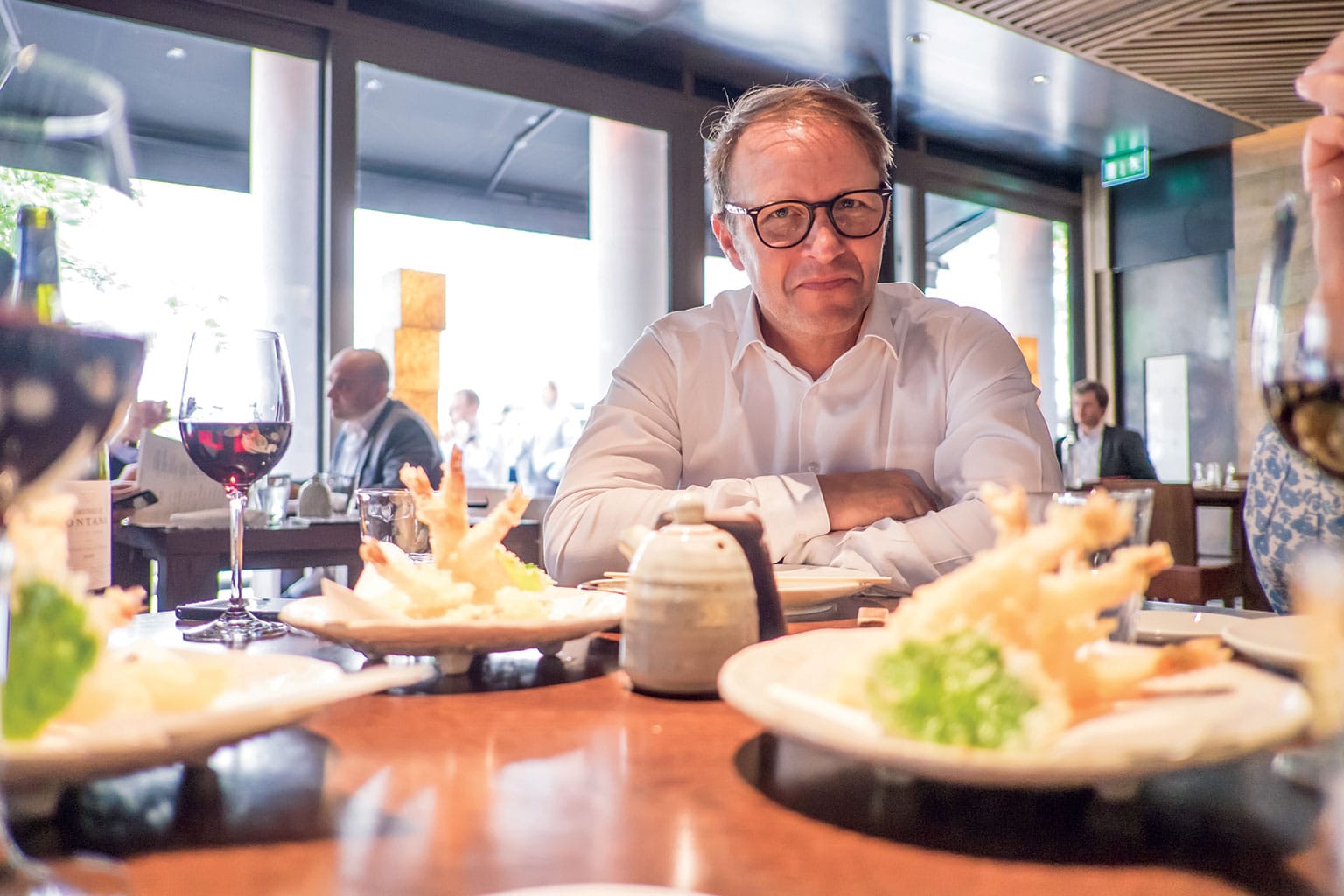Lunch with... Petter Solberg
This Norwegian champion has displayed some pretty fancy footwork over the years - and not only on the pedals of his WRC mounts
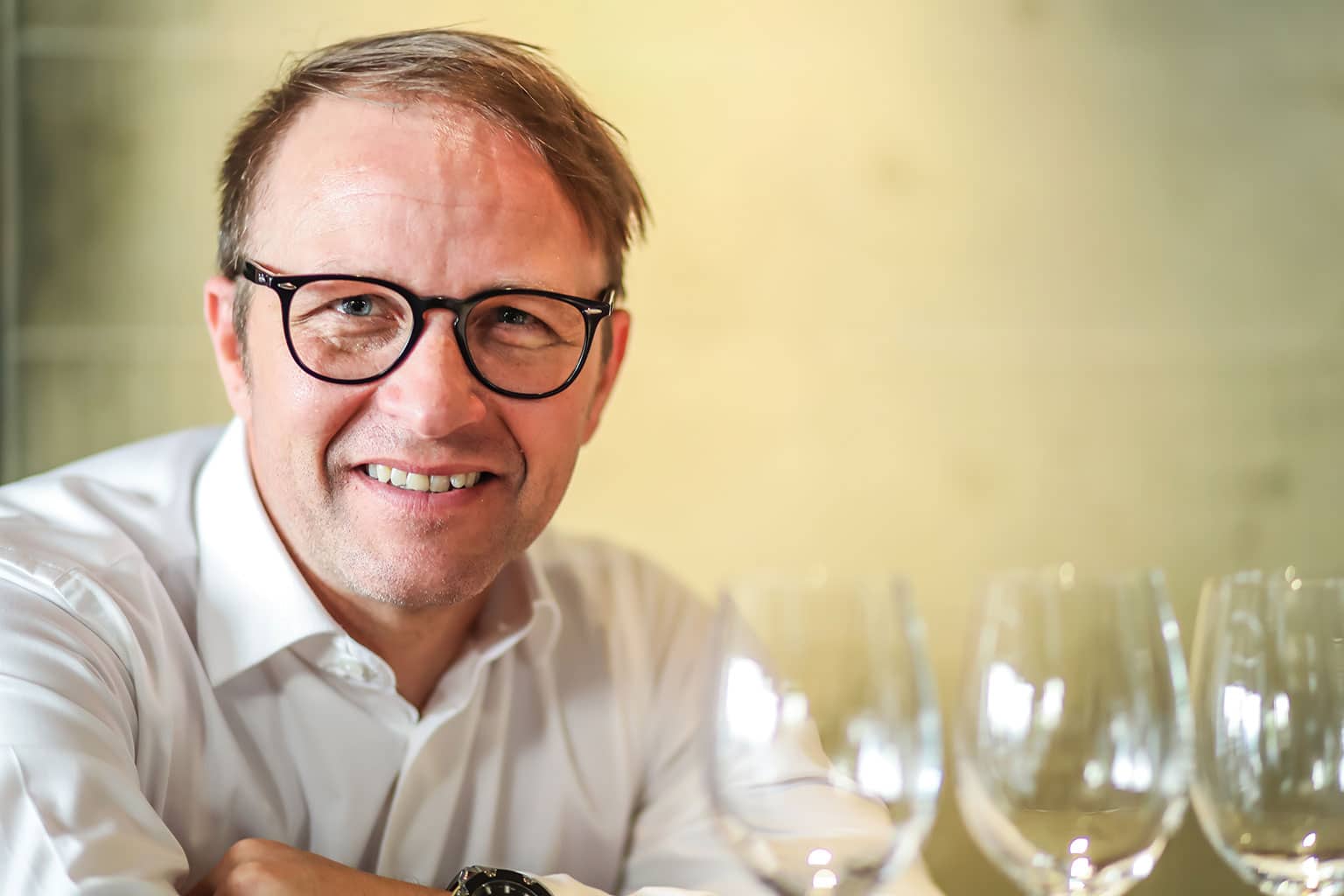
Petter Solberg has been invited to take part in Norway’s Strictly Come Dancing contest 10 times and so far he’s turned down every offer. Not because the highly competitive Solberg is worried about looking a buffoon, but for quite the opposite reason. He’s concerned that he might be too good.
Petter Solberg is, you see, a former Norwegian national dance champion. The fact that he is also the only Norwegian to have won the World Rally Championship might give him a unique double in the world of motor sport. Unless, of course, it has slipped my notice that Richard Attwood as well as winning Le Mans is a champion in the Paso Doble.
We meet Solberg at ROKA on London’s North Audley St, a high-quality Japanese restaurant that is Solberg’s favourite London eatery. He’s in the UK for the British round of the World Rallycross Championship in which he drives one of his own team’s VW Polos, but has taken time out for a few hours with us.
I remember meeting Solberg in Wales in the early Noughties during what was a glorious period for British rallying with superstars Colin McRae and Richard Burns both still competing and at the height of their powers. Solberg came across as fun-loving, extrovert and totally in love with his sport. My impression wasn’t wrong because several colleagues who were rally journalists at the time have told me that Solberg is great fun and that lunch with him would be a pleasure. They’ve also said that dinner would be even more entertaining – the word mayhem was used by one, and that a lengthy recovery period would be required. At 43 years old Solberg looks very fit and lean, more than capable of winning the RX world championship (at the time of writing he was lying third in the championship).
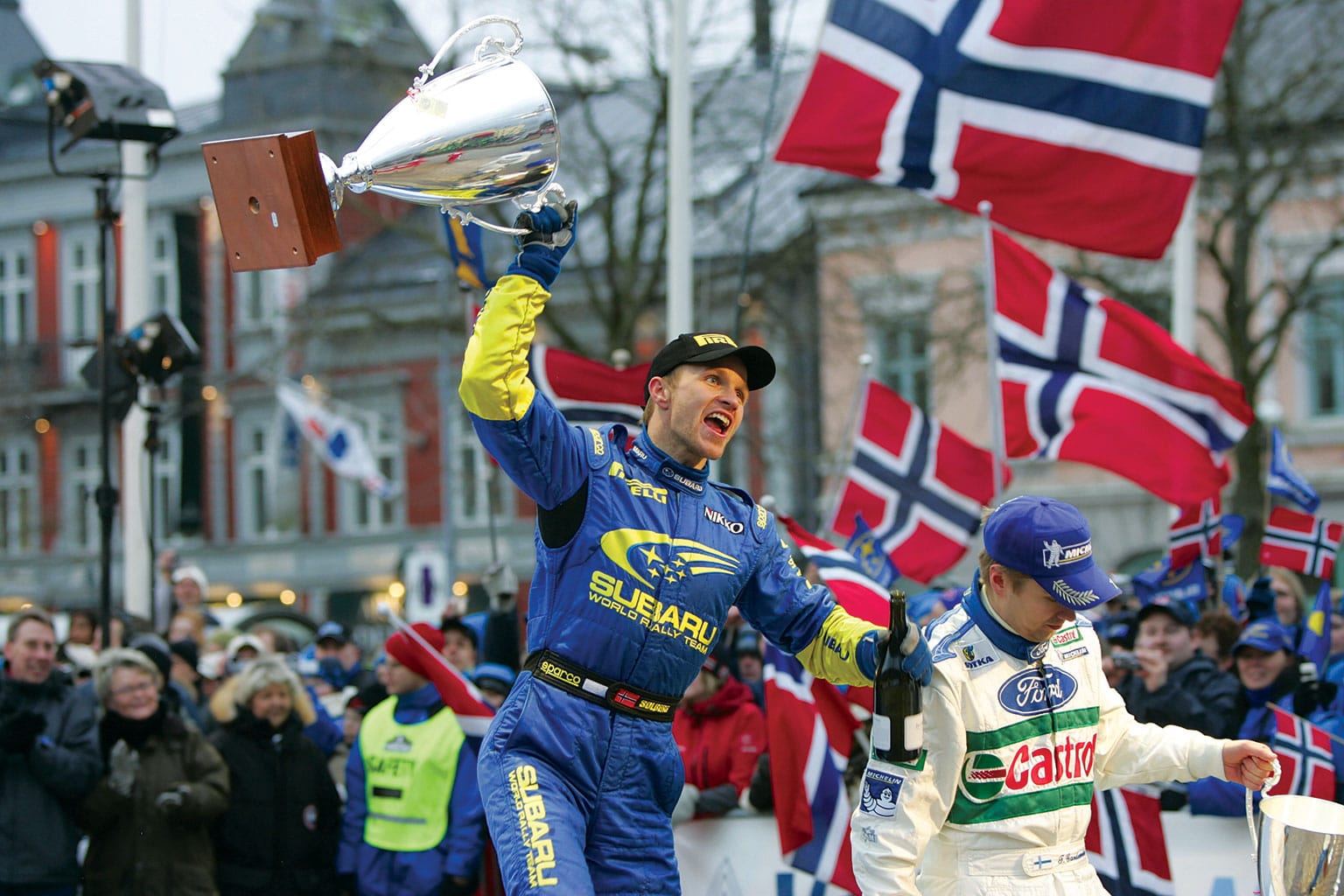
The dancing and the life in motor sport starts in Spydeberg, Norway, where Solberg and his older brother Henning grew up. “Our parents were very keen competitors in Bilcross, which is an inexpensive form of rallycross in Norway. There’s a limit to how much you can spend on preparing a car,” he says, “and you have to sell it to another competitor if they put in a bid. If you refuse to sell you lose your competition licence. The other really good part is that it costs €30 to make a bid, which goes towards organising events, so it’s always been a very successful form of motor sport in Norway. (The Swedes have a very similar series called Folkrace and the Finns, who pioneered this affordable form of rallycross, have Jokamiesluokka.)
“Our parents [father Terje and mother Tove] were very keen competitors but not very good at preparing and tuning their cars. Henning and I, although in our early teens, thought we could do better. The term wasn’t really used back then but I now realise that I have OCD. I was totally obsessed with attention to detail and would spend hours and hours porting cylinder heads and working on the cars. It was an amazing experience, especially because the rules about having to sell your car meant that you were always preparing different things. I reckon that we prepared more than 50 different cars for Bilcross, for our parents and for ourselves when we started competing.”
Before Solberg started driving full-size cars he began with something somewhat smaller. “In 1987, when I was 13, I entered the Norwegian Tamiya Cup for radio-controlled cars. The entry was huge and you were chosen from about 80 local competitors to take part. The trouble was that it required a lot of travelling to the rounds and my mother soon got fed up with it. So I persuaded one of my dad’s friends to take me. Even then I was obsessive about preparation and remember standing naked in the shower carefully washing my competition car down after a heat, making sure that it was immaculate. When I reached the final my parents turned up out of the blue to support me and bought me a new motor after my original had burnt out. That was about the only time they stepped in financially, otherwise I was made to support my passion myself.”
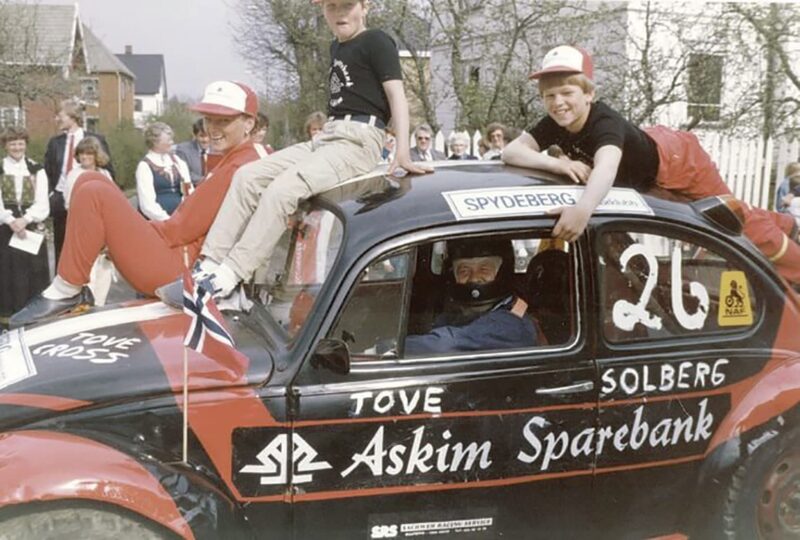
The Solberg boys atop the family VW Beetle. Their father Terje and mother Tove were both keen competitors
Motorsport Images
From models he switched to Bilcross three days after his 18th birthday in 1992. By 1995 he was dominating Norwegian rallycross and hillclimbing, winning both championships that year and the year after. In 1995 he also took part in his first rally at the wheel of a Volvo 240. A large Solberg family gathering would be the place to be if you love rallying and loose-surface motor sport because there is hardly a member of Solberg’s family who doesn’t have form. Petter’s navigator in the Volvo was Maud Tidemand, mother of current WRC2 champion Pontus Tidemand and today Maud Solberg is married to Henning.
Nice to keep it all in the family, but what if one brother was quicker than the other. Tension perhaps? “Henning is a fantastic driver,” says his younger sibling. “You don’t become Norwegian rally champion five times in a row without a lot of talent. But usually I was quicker. The most pissed off he ever was with me, I think, was at the 1998 Rally Finnskog, a round of the Norwegian championship. I was driving a Toyota Celica sponsored by Shell Norway, local companies and supporters. I’d been about 1.7sec faster than Henning on the first stage when the car’s power steering pump developed a massive leak.
“We couldn’t fix the leak so we got hold of a 25-litre plastic tank that we taped and tied to the roof of the car and led a hose from it to the power steering fluid reservoir. It looked ridiculous but it worked. Well enough for me to be 2.2sec faster than Henning on the next stage. He went absolutely crazy. Totally mad at me, so angry that he said that he was going to launch a protest against my car and its unconventional roof tank. Fortunately all the other drivers said to Henning, ‘Don’t be crazy, he beat you with a heavy tank of fluid on his roof, you’ll look stupid if you protest.’ So thankfully he didn’t.” No doubt big brother perked up soon enough because it was the next year that marked the start of his five-year run of national championship successes. Helped, naturally, by Petter being away in England kicking off his WRC career.
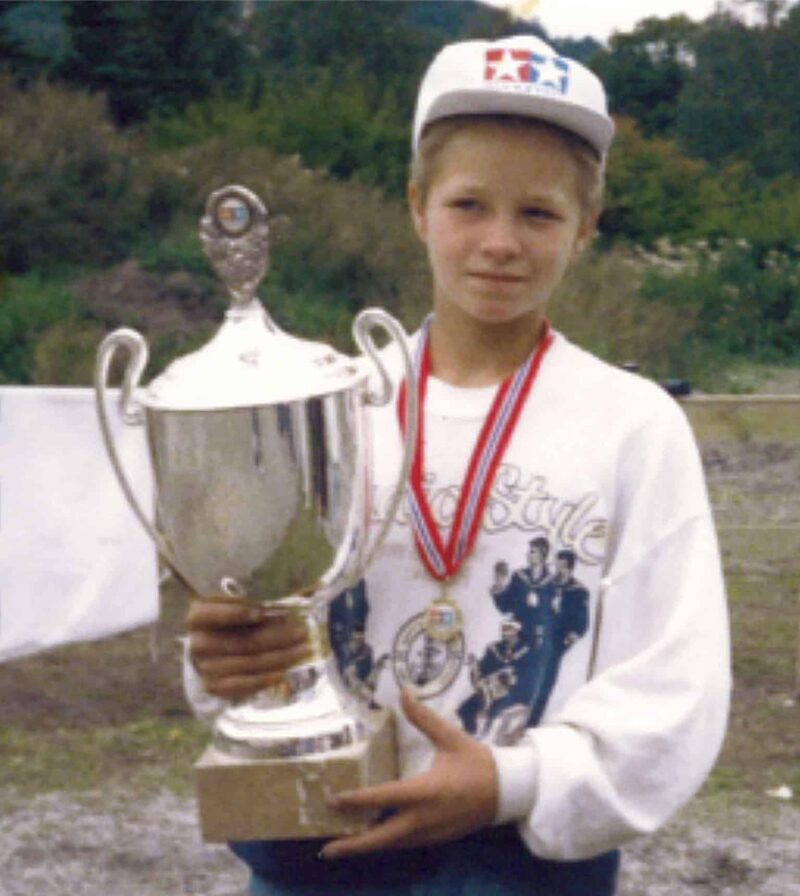
Solberg cradles the cup he earned by beating rivals in Norway’s 1987 Tamiya Cup
Motorsport Images
Solberg Jr’s potential had been noticed by WRC team managers, including Malcolm Wilson who gave him the chance to take part in a shoot-out. He won and was given the job as junior driver in Ford’s 1999 rally squad, which included Ford new boy Colin McRae. “I didn’t speak a word of English,” says Solberg, “so it was quite daunting. Fortunately, I couldn’t have been in a better place than with Malcolm and Elaine Wilson. There was a real family atmosphere that was ideal for me.”
I’ve met the Wilsons several times and that’s exactly how they came across to me. In fact, I was reminded of Ken and Nora Tyrrell. In my experience, if you want to know what the atmosphere was like in Formula 1 in the 1960s then you should go to a World Rally Championship event. “That’s an interesting point,” says Solberg, “and I think you’re probably right.” The journalists and photographers who cover international rallying have the relationship with drivers that used to exist in F1 50 years ago. Which is why any journalist can trot out endless anecdotes about McRae/Solberg et al.
So what was it like being team-mate to McRae? “He was a lot of fun; he was extremely competitive and took the driving seriously, but he was very friendly to me and we had great times. I remember hours spent at his place playing rally games: Colin’s Sega Rally game was being developed and we were playing it to test it out.” Any cracking McRae stories of partying and high jinks? “Yes,” says Solberg, “but you might not want to print it.” And he’s right, we couldn’t possibly commit to print the tale that Solberg goes on to tell from an Acropolis Rally.
It was intended that Solberg keep a low profile in the team while Thomas Rådström played understudy to McRae, but in the run-up to the 1999 Safari Rådström was injured and had to miss the African event. Solberg was entered as a nominated points-scoring driver. Some event for your first WRC outing. “Absolutely. The Safari is unique, not like any rally I’d ever contested in Europe.” Different, but obviously not too great a challenge for Norway’s finest. Solberg finished fifth and scored driver and manufacturer points.
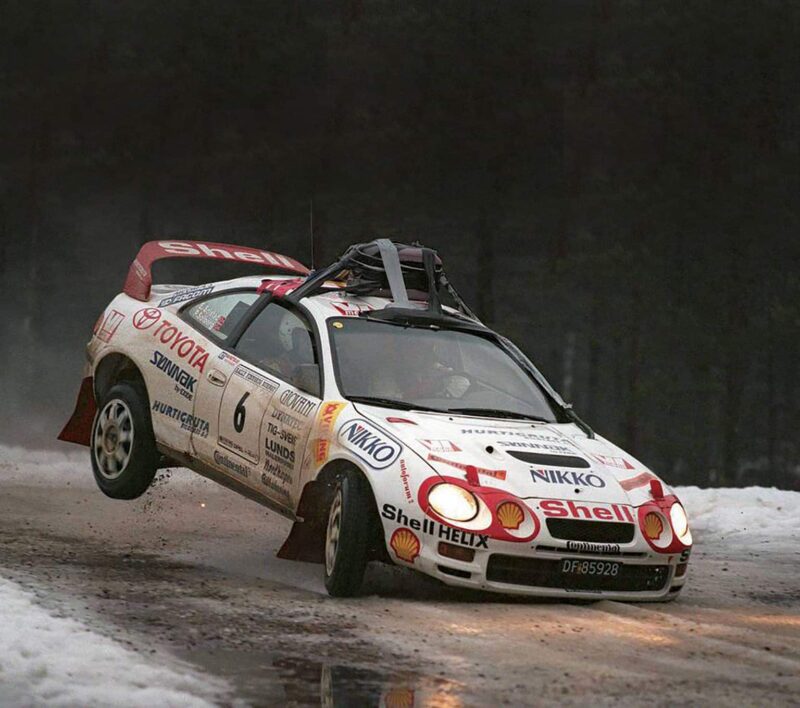
With a makeshift power steering reservoir strapped to his roof, Solberg heads for victory on the Rally Finnskog, 1998
Motorsport Images
Reading the notes in Kenya was Fred Gallagher. “What a lovely bloke,” says Solberg, “a real gentleman.” Gallagher was a temporary co-driver, but his regular sidekick who would follow him from Ford to Subaru in 2000 was Welshman Phil Mills. So you spoke hardly any English and paired yourself with a Welshman? “I tried four different co-drivers and Phil was the only choice. We hit it off straight away.” So, the right co-driver selected, a family-run team and the backing of a motor industry behemoth. Good to go. Except Ford wasn’t able to put a long-term contract and enough money on the table.
“The family farm was mortgaged,” says Solberg, “and Phil and I knew exactly where we wanted to go. He didn’t want to return to national rallying and I wanted to be world champion.” The pair went to Subaru to join Richard Burns and Juha Kankkunen. “Richard was quite a different personality to Colin,” says Solberg, “less outgoing but still easy to get along with. It was quite different being with David Richards [at Prodrive] and Malcolm Wilson. Malcolm was involved in absolutely everything whereas at Subaru it had much more the feel of a factory team. Different, but both highly professional.”

Solberg flies high in Argentina 2000, his first season with Ford
Motorsport Images
This is exceptionally good sushi. I’m following Solberg’s choices with tiger prawns and then beef. Clearly a man with good taste in grub. “I brought the chef from Subaru to my own team because he’s so good.”
I suggest that the rumour he used to live on spaghetti when he first came to the UK might be untrue. “With ketchup on? No, that’s right. Our mum used to cook us simple food on the farm so that’s what I was used to.”
The combination of pasta, Heinz, Prodrive and a Subaru certainly worked for Solberg and Mills. It was Richard Burns’s year in 2001 but in the following season Solberg won his first WRC round at that year’s Rally of Wales, the first of multiple wins in the principality. Why was he so successful there? “Our Pirellis were very good, but also the conditions and stages were very similar to what we have in Norway, so I felt at home.
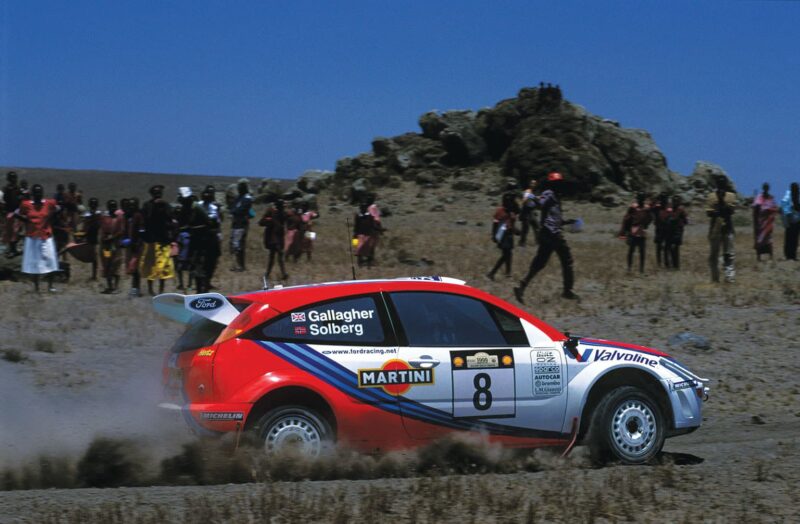
After team-mate Radstrom is injured, Petter is a surprised substitute on the 1999 Safari Rally. He and Fred Gallagher finished fifth
Motorsport Images
“I was thus very confident at the start of 2003. I was still very young but the car was really good, Phil and I were working together well and the team was great. I knew we could win the championship if we were consistent.” The season got off to a disappointing start with a retirement on the Monte, then sixth in Sweden and another retirement, this one in Turkey. Then the consistent results started coming.
“The biggest disappointment was San Remo,” says Solberg, “when there was an electronics failure in the active suspension. It was a good system that usually worked well, so that was really disappointing. But Corsica followed and made up for that. We had the most enormous accident on one of the stages. We went off the side of a mountain and managed, thankfully, to hit the only telegraph pole within miles. The car ended up in a right mess. Unbelievably, though an enormous effort, the team managed to rebuild the car overnight. I don’t think that any of the wheels were pointing exactly where they should have been, but we won the rally the next day. It’s one of the most memorable victories of my career.”
“Colin McRae was a lot of fun. We had great times. I remember hours spent at his place testing his rally game”
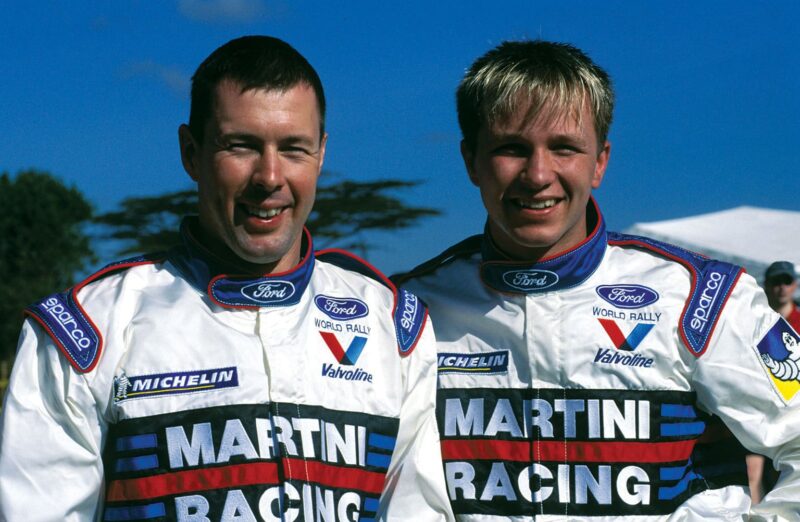
1999: Team-mates with Colin McRae in Malcolm Wilson’s Ford team.
Motorsport Images
But nothing compares to that last round victory in Wales. “I was really nervous – the whole championship was down to that rally. I was staying in this really nice little hotel. I had a little brandy, just the one to try to settle my nerves. And I looked out of the window into the forest and I said to myself, “Bloody hell, I can do this. It was an amazing event with all the champions there. Amazing atmosphere.
“At home in Norway there was a really important football match on with the king and prime minister watching. They stopped the action to show live coverage of the last stage and me winning the rally and the championship. When I pulled into the finish the team said to me, ‘Don’t swear, Petter, this is going out live’ but I was so overjoyed the first thing I said was ‘f***ing hell, we’ve done it’ over and over again.
“When I got home there was a huge reception with 10,000 people there. Quite incredible. For certain it was one of the most emotional moments of my life but, to be honest, I’ve always been one to look forward. It was a great moment but straight away I was thinking about future success. I still am.”
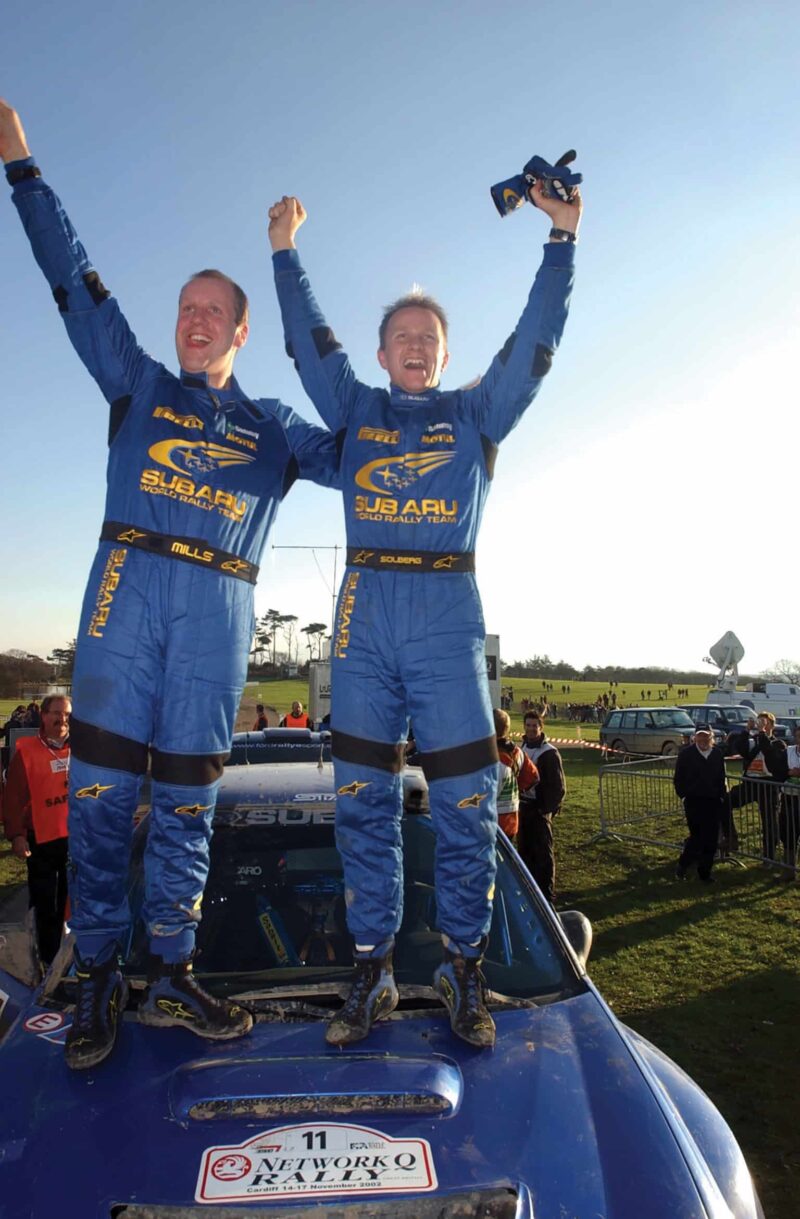
On top of the world in 2002 after Solberg and co-driver Mills scored their first WRC win on Rally GB
Motorsport Images
Solberg beat up-and-coming driver Sébastien Loeb in Wales that season. Ah, Loeb. Why has he won so much? “Well, clearly he is a fantastic driver,” says Solberg, “but it is also down to consistency; not changing too many details on the car, evolving it gradually.”
Accidents. It’s rallying, there are going to be some spectacular offs. “One of our most dramatic, and the one that makes the best tale, is the crash we had at Rally Deutschland in 2004. I hit this stone on the side of the road and we had a hell of an accident. Phil’s side of the car was destroyed and he was pretty bashed up. I went to see him in hospital that evening and he was absolutely black and blue. And in a lot of pain, so they’d filled him up with morphine. I asked him how he was and he said that he was fine and raring to get back in the car. He’d have got out of bed and carried on with the rally.
“But it was a serious problem because it was only two weeks to go before the round in Japan. Terrible timing. The first WRC round ever in Japan, Subaru’s home, and we’re reigning champions. Unbelievably Phil managed to recover in time for us to take part. And we won. That round and the next two after it. We should have won another world championship that year and probably the year after it. But hey, that’s how it is.”
Back home in Norway the Schumachers had moved in. Well, they bought a holiday cottage not far from the Solberg farm.
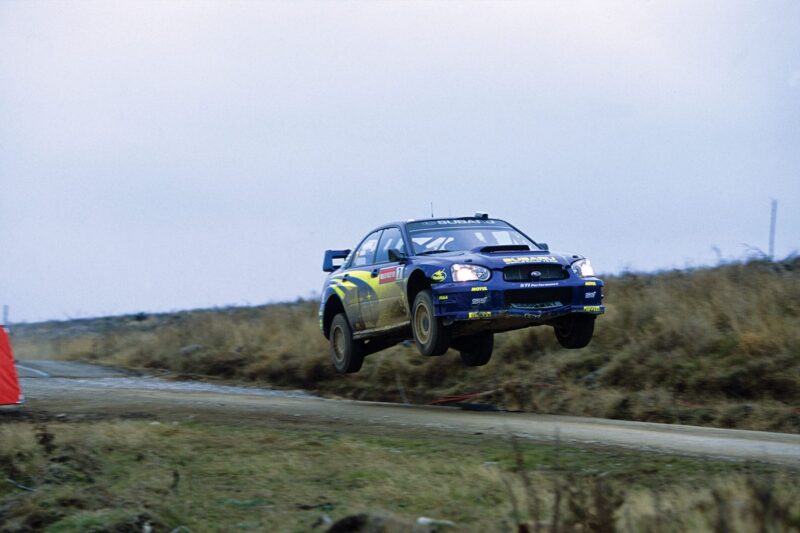
2003 and Solber and Mills storm the WRC season to secure their first world championship together
Motorsport Images
“Michael and the whole family came over and I took all of them, including the kids, out in a rally car. Michael was fascinated by the lack of grip and how the car danced across the gravel. ‘This would take me a long time to get used to’ he told me, ‘but I don’t think you’d have so much trouble adjusting to a Formula 1 car’.
“I did actually have a go in a Ferrari at Fiorano in 2009. It was exciting, but the downforce and grip were so different from what I’m used to.”
I can’t see Petter Solberg in the world of Formula 1. Even Le Mans wouldn’t quite fit. His whole philosophy of life and his sport is wrapped around the tenet that it has to be fun and enjoyable.
We haven’t yet visited all the branches of the Solberg motor sport tree. Swedish wife Pernilla is the daughter of Per-Inge Walfridsson, works Volvo driver, European rallycross champion and fourth place finisher in the 1974 RAC Rally. Pernilla herself was a top international rally drive with many impressive WRC results, particularly in Group N. Hardly surprising then, with this left-foot braking/loose surface gene pool, that the offspring of Petter and Pernilla Solberg is a very promising driver.
“I’ve just come back from watching Oliver compete in the Rally Talsi in Latvia. He’s competing in both rallying and rallycross, but his big ambition is to make it into the WRC. As long as he’s enjoying himself we don’t care. He has to have fun. He’s doing so much of it himself. I’ve been with him to show him how to make pace notes, but that’s about all the help I’ve given him.”
Solberg can add another first to his only Norwegian WRC champ/dancer accolades: he became the first driver to have won FIA world championships in two different motor sports when he won the inaugural World Rallycross Championship in 2014 and then retained it the year after.
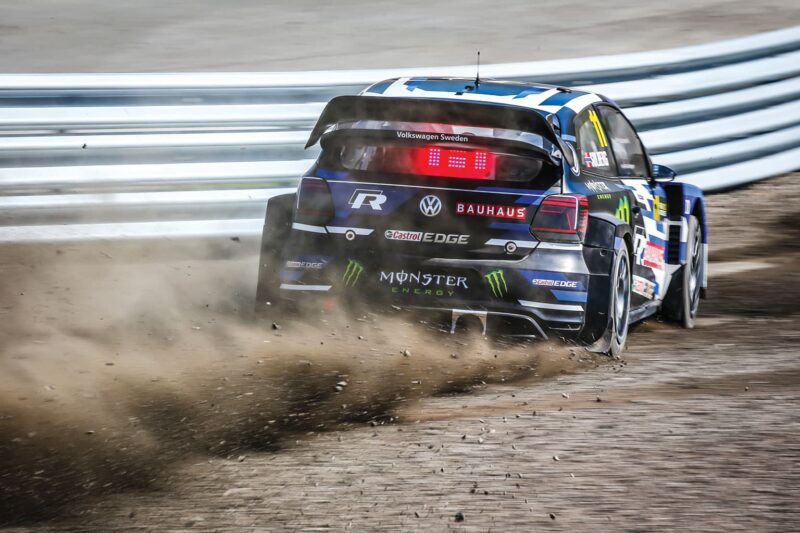
Chasing WRX success with VW in 2018
Motorsport Images
WRC or WRX? “They’re very different,” he explains. “Rallying is rallying and for me the excitement of driving flat out for as many as 30 kilometres, always on the edge, cannot be matched. Rallycross is over a bit too quickly, but it does have other factors that make it exciting. The cars are extremely powerful, of course, which is great, but you also have the other competitors to think about. In rallying it’s really just you, your co-driver and the stage. What other drivers are doing doesn’t really enter into it.”
What about a return to the WRC one day? “Yes, I can see that happening one day. We’ll have to see how everything turns out. If Oliver carries on with his career and reaches his goal of being in the WRC, there’s no way I’d have time to do it as well.”
Last Christmas a pearl-white McLaren 675LT turned up outside the Solberg home in Sweden, wrapped with a red ribbon with the words ‘To Petter, love from Petter’ written on its side. “My wife had a bit of a fit. She said, ‘I occasionally buy myself a handbag and you’ve bought yourself a supercar.’ It’s lovely; they’ve only made 11 in that colour.”
Solberg has a significant car collection. ‘I’ve got about 27 cars including my championship-winning Subaru and a Mk2 Escort that Phil Mills’s company built for me. It’s a good collection but you should see my in-laws’ museum. They’ve got over 70 cars. Well, 69 cars and the first Volvo truck ever made.”
Petter Solberg is one of the most rounded professionals you’ll meet. Few drivers have managed to achieve his level of professionalism both in the car and as a team owner, yet still attack life with a sense of fun.
As for the dancing, did it help? “I learnt dancing to meet girls. But sure, to be a good dancer you need excellent coordination and balance. The same things you need to be a top rally driver…”
